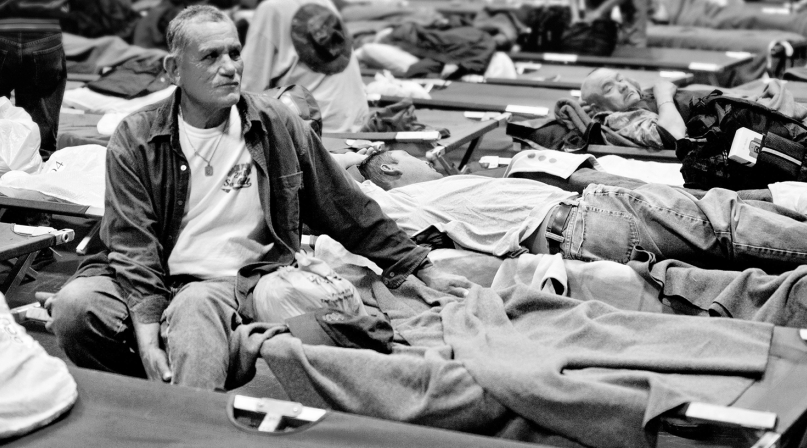10 Strategies to End Chronic Homelessness
Upcoming Events
Related News

We can end homelessness for people with the most complex needs in our communities, including people with disabilities with the most extensive experiences of homelessness. We know the solution — supportive housing — and have seen it work across the country. However, ending chronic homelessness takes political will, leadership, collaboration and coordination among multiple state and local programs to align resources for housing and supportive services. To help you do this challenging work, we’ve compiled 10 strategies you can use to drive progress in your community.
1 Start at the Top: Get State and Local Leaders to Publicly Commit to and Coordinate Efforts on Ending Chronic Homelessness
One of the key lessons we have learned through our work ending veteran homelessness is that commitments from — and cross-sector coordination among — state and local elected officials can create the urgency necessary to achieve an end to homelessness. The same is true for ending chronic homelessness. Governors, mayors and county leaders can convene the appropriate partners and drive accountability. And they can ensure that strategic planning is coordinated and that health, behavioral health, reentry and housing policies and resources are available and aligned to scale and deliver supportive housing to achieve this goal.
2 Identify and Be Accountable to All People Experiencing Chronic Homelessness, including People Cycling through Institutional Settings
You can’t solve a problem you can’t see. Solving chronic homelessness is only possible if every individual experiencing or at risk of it is located and identified across a variety of settings, and their progress in engagement and housing placement is tracked in real time. To do so, your community should conduct coordinated outreach, implement data-driven targeting by using and cross-referencing data sets (e.g., Homeless Management Information System, Medicaid, jail/corrections), and use other methods to identify people experiencing or at risk of experiencing chronic homelessness, including people cycling between homelessness, jails and hospitals. By tracking engagement efforts at the person-level, such as with an active list, communities can better monitor their progress and hold themselves accountable to quickly helping every individual experiencing chronic homelessness.
3 Ramp up Outreach, In-reach and Engagement Efforts
Persistent, coordinated and creative outreach efforts — and in-reach into institutional settings — are vitally important to the ability to not only identify, but engage, people experiencing chronic homelessness and link them to the housing and services interventions available in your community. That involves:
- ensuring that outreach efforts are comprehensive — covering a full geographic area and the multiple settings within it — and coordinated across all teams and providers
- sharing information across outreach teams and sites, and coordinated with other systems, including law enforcement, hospitals and emergency departments, prisons and jails, libraries and job centers
- partnering with Health Care for the Homeless (HCH) grantees and Projects for Assistance in Transition from Homelessness (PATH) grantees who can have a powerful impact on improving care coordination and optimizing resources
- partnering with law enforcement, prisons, jails and hospitals to conduct both in-reach and outreach to reduce the cycle between homelessness and criminal justice system involvement.
These efforts should seek to reach and connect with all people who are unsheltered within your community, including people living in encampments or tent cities, as well as people in institutional settings, such as jails and hospitals. All outreach should be person-centered and emphasize building rapport and trust as a means of helping people obtain housing with appropriate services.
4 Implement a Housing-First System Orientation and Response
Communities must adopt a “housing first” approach across their entire system to ensure that people with complex needs can exit homelessness as quickly as possible. To drive such transformation, communities should adopt uniform measures of success that emphasize permanent housing, with the right level of services, as the goal for people experiencing chronic homelessness. Other strategies include:
- reducing or removing barriers for applicants with substance use issues, poor credit or financial history, or past involvement with the criminal justice system
- coordinating with legal services organization to address individual and systemic legal needs of people experiencing chronic homelessness
- creating strong and direct referral linkages and relationships between the crisis response system — local shelters, outreach programs, hospitals, police departments — and supportive housing, and
- ensuring that all staff in shelters, outreach teams and housing settings are trained that substance use, criminal histories or motivation are not obstacles to successful tenancy in housing.
5 Set and Hold Partners Accountable to Ambitious Short-Term Housing Placement Goals
Many communities have established ambitious monthly, quarterly or 100-day housing placement efforts, sometimes called housing placement “surges,” to break down the larger goal of ending chronic homelessness into focused blocks of time and effort, while pushing their systems to perform with maximum efficiency and better outcomes. These goals can be met by:
- creating and sharing a community-wide list of people experiencing chronic homelessness
- using a tested and validated assessment tool and process to prioritize and target interventions
- using navigators or guides to address individuals’ needs
- monitoring progress rooted in access to housing on a weekly or monthly basis.
6 Prioritize People Experiencing Chronic Homelessness in Existing Supportive Housing
In many communities, the supportive housing opportunities that have been created have unfortunately not been well targeted. In fact, national data shows that only about 29 percent of existing supportive housing is targeted to individuals experiencing chronic homelessness. You can maximize the impact of existing supportive housing by adopting a policy that prioritizes individuals experiencing chronic homelessness for any newly created units, and for any units that become available through turnover, unless there are no longer any individuals experiencing chronic homelessness remaining.
Coordinated entry is a critically important approach for prioritizing and matching people experiencing homelessness to the most appropriate housing and services. Within coordinated entry systems, communities can use data-driven approaches to prioritize people experiencing chronic homelessness who have the most significant needs for housing and services.
7 Project the Need for Additional Supportive Housing and Reallocate Funding to Take It to the Scale Needed
To end chronic homelessness, communities must have an adequate supply of supportive housing to assist individuals who are currently experiencing chronic homelessness and those who are likely to be chronically homeless in the near future. Some communities can make significant progress toward the goal just by improving the targeting of existing units. Most communities will also need to expand their supportive housing inventory through maximizing both targeted grants and leveraging new mainstream resources.
The degree to which resources meet this current and future need will vary from community to community. A good starting point is to use data to assess whether your community has a gap in supportive housing availability, and if so, to determine the size of that gap.
To expand the supply of supportive housing, communities can also monitor the performance and cost effectiveness of programs within their homelessness service system and reallocate funds to the programs with the best outcomes. Reallocating funds is one of the most important tools by which communities can make strategic improvements to their system for ending homelessness.
8 Engage and Support Public Housing Agencies (PHA)and Multifamily Affordable Housing Operators to Increase Supportive Housing through Limited Preferences and Project- Based Vouchers
By partnering with public housing agencies and operators of HUD-financed multifamily housing, communities can expand the supply of supportive housing, as well as create new housing opportunities for current residents of supportive housing. Specifically, PHAs and operators of multifamily housing can:
- establish a limited preference, committing Housing Choice vouchers, public housing units and multifamily housing units to serve people experiencing chronic homelessness, which communities can couple with supportive services
- use project-based Housing Choice vouchers within apartment buildings being developed to serve as supportive housing
- increase opportunities for tenants of supportive housing who do not need the intensity of services provided to “move up” through Housing Choice vouchers and other affordable housing and employment services, freeing up supportive housing opportunities for people experiencing chronic homelessness.
9 Leverage Medicaid and Behavioral Health Funding to Pay for Services in Supportive Housing
Supportive housing combines affordable housing with a tailored package of supportive services that help people achieve housing stability. Implementing successful supportive housing requires consistent and effective supportive services, which in turn require reliable and sustainable funding. One of the most promising sources of sustainable financing for these services is Medicaid.
As federal guidance has clarified, states have the option of ensuring their Medicaid plans cover housing-related and supportive services that help people find and keep their housing and connect to care. States can supplement Medicaid with behavioral health system funding, such as mental health and substance abuse prevention and treatment block grants. By leveraging Medicaid and behavioral health funding for supportive services, communities can shift HUD funding toward providing rental assistance for additional units.
10 Help People Increase Their Income through Employment Opportunities and Connections to Mainstream Benefits and Income Supports
By combining affordable housing with supportive services, employment opportunities, and income supports, communities can help individuals with disabilities achieve stability and independence. A critical way to provide that stability is by connecting eligible people experiencing chronic homelessness to Supplemental Security Income and Social Security Disability Insurance benefits, and by increasing income through connections to employment opportunities and workforce programs.
Attachments
Related News

White House signs Executive Order on state AI lawmaking
President Trump signed an Executive Order (EO) aimed at mobilizing federal agencies to challenge existing state laws on artificial intelligence.

Tumultuous ’80s test NACo’s fundamentals
NACo took two entrepreneurial risks in the 1980s — one nearly bankrupted the organization and the other has gone on to pay dividends for more than 40 years.
